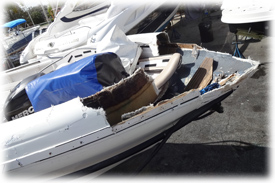![]()

Damaged Bow Section of the Yacht’s Tender
A Horrific Night for the Crew of a Benetti Motor Yacht
On the evening of Thursday November 21st, an Urgent Assistance call was received on VHF channel 16 at the dispatch desk of TowBoatU.S. Ft. Lauderdale from a 121’ Benetti. The vessel was dead in the water in 8’- 10’ seas, lying beam to the sea and taking on water. The moments that led up to this call involved the vessel suffering an apparent hydraulic failure while steaming east toward the Bahamas with their 20’ tender in tow. The yachts engineer attempted to perform a temporary repair to enable the yacht stay on schedule. Instead of continuing their trip to paradise, what happened as the yacht was clutched into gear almost immediately put an end to those plans. The hawser for the yacht’s tender had become entangled in her running gear and came tight as the shafts began to turn. Both main engines shut down and as the vessel turned beam to the sea, she began to roll violently. As the tender drew closer to the yacht, it came to rest under the bow flare and was being demolished with every passing wave as the yacht rolled. The call went out!
Within minutes of receiving the distress call, TowBoatU.S. Ft. Lauderdale had three boats underway. Two of these were 31’ twin diesel tugs and one was a 29’ foam collared fast response boat. By the time the 1st of these boats arrived on scene, the crew of the yacht had donned their life jackets and was preparing for the worst. The crew noted that the waves approached ten feet at times and those on the top deck could touch the top of the waves as the chine dipped into each trough. Salvage Master, Kevin Collins was first on board, he estimated that the roll was as much as 25 degrees as some of the larger waves rolled under the casualty. The process of getting on board and passing pumps was incredibly challenging in these conditions. He was transferred from the transom of a 31’ tug and had to leap on board by grasping the rail on the port side of the yacht. Passing dewatering pumps and getting another captain on board the casualty was equally challenging. Once on board, Collins went to work interviewing the crew to get a full understanding of the situation. He noted that it was nearly impossible to stand in the wheelhouse do to the brutal sea conditions. Dewatering pumps were staged and energized in several areas in the aft section of the boat including the control room and garage which were heavily flooded. Waves crashed onto the back deck with water volumes so great that they caused intermittent failure of the gas powered pumps. Several sources of flooding were discovered near the transom of the boat and the waves crashing on deck added to the flooding.
While Collins worked to control flooding on board, the remaining crew was busy working to free the tender and get the yacht in tow. Two towboats and three TowboatU.S. Ft. Lauderdale crew members took on the task of freeing the tender. After rigging a suitable method to tow the tender which was missing all of its deck hardware from the constant impacts with the yacht’s hull, it was cut free and in tow toward land. Shortly thereafter, lines were passed to the bow of the casualty from the captain of one of the 31’ tugs and the yacht began to creep to the west. With the sea conditions and the weight of the partially flooded casualty, towing speed averaged less than 1 knot and forward motion was nearly stopped at the top of each wave. Shortly after the tow commenced, the towing hawser parted and the yacht was again adrift and turned beam to the sea. After rigging another hawser and getting back in tow, it was quickly realized that a stronger tug would be needed to safely tow the casualty to safe harbor.
Collins called for the company’s 46’ tug with a crew of three to get underway in order to take over the tow. Collins recalls, “Conditions were dangerous on board the casualty as we turned to the south in tow bound for Port Everglades. The yacht was beam to the sea once again and we were not even making 1 knot! I monitored flooding as the 46’ tug approached, the skies opened up with one of the worst thunder storms I can recall. The tow was transferred without incident and towing speed picked up to about 4 knots. The rain was so heavy that I could barely see the tug only a few hundred feet in front of us. I stationed a 31’ tug ahead of the 46’ tug with a tow line faked out on deck all ready to be passed in the event of another towing hawser failure and to guide them as they approached shallow water. Nerves were taught as we approached the entrance to Port Everglades with rock jetties to our North and South, a Northeast wind at 20+ knots and an outgoing tide. The waves were standing straight up and the tow was coming to a complete stop at the top of each wave. Thankfully, we arrived safely inside the inlet where additional pumps were passed and the job of dewatering the vessel could be completed”
The vessel was towed to a local boatyard where the yacht’s crew sighed with relief when their feet touched solid ground! The crew members at TowBoatU.S. attempted to get to sleep at about 2:00 A.M., most with too much adrenaline moving through their bodies to have any chance of sleeping! In the end, the yacht was saved from certain catastrophic loss and the insurance company was saved from the related expense. The hard working and talented crew at TowBoatU.S. Ft. Lauderdale had the opportunity to do what they love most which is solving complex marine problems, this was certainly one of the best examples in the 25 years that the company has been in business. Company president Larry Acheson commented, “I was proud of everyone on the team, from dispatchers to mechanics to captains and everyone else that had a hand in the success of this operation. Our boats ran perfectly, our pumps worked properly, our communications and electronics served us well and our people drew upon their training and experience to save a group of people and their yacht. I couldn’t be happier!”










